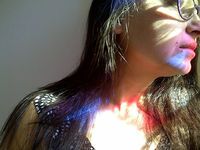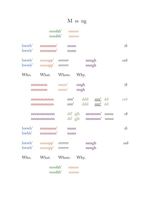Margaret Christakos on Poetry Exercises
By Jennifer LoveGrove
Today's feature on poets and writing exercises, the final in this series, is Margaret Christakos. She's the author of nine collections of poetry, including Multitudes (2013), Sooner (2005) and What Stirs (2008), a novel, and an intergenre exploratory memoir that includes photographic work called Her Paraphernalia: On Motherlines, Sex/Blood/Loss & Selfies (2016). Her new publication is Space Between Her Lips: The Poetry of Margaret Christakos, selected by Gregory Betts (Spring 2017). In Fall 2017, she will begin a tenure as Writer in Residence at the University of Alberta.
What do you do when you’re stuck, when the writing is not coming readily, or maybe not at all? Or perhaps you only have a limited block of time in which to write and you want to dive in but you aren’t sure where to begin? What do you do to get started?
When I’m stuck, I go back to some of my primary questions about poetry and address: Who am I talking to, directly or indirectly? Why? How does my poetry uncoil from private to public? How is my voice situated in relation to other voices? I’m interested in the intersection of improvisation and the choral — poetry that draws in and draws out multiple voices, and that responds to being in time. This set of preoccupations also grows from my longstanding interest in the poetic series, whether texts that use the form of diary entry, travel chronicle, domestic routine, idea notebook, or a sequence of poems that mutate and shift in relation to each other.
As well as with page form, I like to experiment with the range and register of my voice, and some of this comes out of a sound poetic practice. Often I walk around the house singing — not particularly “well” at all — just moving through my house and oralizing. Sometimes I use words and other times I let words deliquesce to sung units of sound and breath. Halfway up the stairs you feel the echo system of the house kick in and your voice balloons and wobbles out. Suddenly you have this wide elastic voice coming out of your lungs, and it feels like a bolt of fabric flapping in a wind. Then you gurgle and make very low dirge-y tones standing in a dark hallway and both narrative and poetic ideas occur. They just do. Ideas and sensations “poke” each other. I recommend this sort of investigation of voice to writers. Feeling stupid or strange happens almost instantly — and you can think about how incredibly narrow is the range of voicings our society allows to its “well-regulated” subjects.
So that’s one. I use my voice to expand how I normally — in social spaces — use my voice. And that lets me think about all the regulations we place on our voices, on making sense, on making music and being in our bodies. Because a great deal of advice about writing takes us pretty staunchly out of anything below the neck and above the wrist.
Do you use writing prompts or poetry exercises? If so, where did you learn or find the techniques? If you don’t use any kind of prompts or exercises, why not?
Yes, I use lots of attention procedures to remain inside the curious space of a phrase, to hear it inside out, letters reordered, and then again I sound it out. I try to read aloud reversed and mixed up words. I compare the sensation of reading a word I recognize and feel “in charge of” with reading aloud a group of sounds that are for all intents and purposes totally foreign to me semantically. This toggle is pretty interesting — it trades in recognition, misrecognition, interpretation, translation, slippery hearing.
I learned to listen this way to language, and to interact with it, from bpNichol, from the Four Horsemen, also from free jazz, from Meredith Monk, from Nicole Brossard, from Erin Mouré, from M. NourbeSe Philip, from Rachel Zolf, from Kaie Kellough, from Angela Rawlings, from Eva Hesse (in her sculptural forms that seem like organs folded inside out), from Philip Glass, and from site-specific visual art practices.
Why do you use this method? What about it works for you?
Most of these methods investigate an experiential stance to writing as a relational act of being and remaining inside a mode of time-based discovery. Oh cool, look at that, cool and look are palindromes, etc. Spend a bit longer, summon in “local, loco, coal, close, low, cowlick, lock,” etc.
Your CanLit News
Subscribe to Open Book’s newsletter to get local book events, literary content, writing tips, and more in your inbox
Do you these methods in your own writing, in teaching if you teach writing, both, or neither? Why or why not? If you use them in teaching, what sorts of responses do you get from students?
Sometimes I fold these questions for poetry into teaching by presenting to the participants a prototype, and then creating the conditions for us to generate together a collectively-made, site-specific, series-structured group performance. I’ve gotten to enact some of these interactions during my recent tenure as writer in residence at Western. It’s interesting what happens when writing is allowed to include the arrangement of bodies in the room, trying both stillness and movement, rearrangement, and multiple iterations. Silence, waiting and watching and listening to others becomes a primary part of composition. With Kathyrn Mockler’s class I suggested the idea of all the students writing personal associations in relation to a eight different ways of thinking about food: food you dislike, eating too much, eating alone, etc, and then several reversions and reiterative modes of writing were also tried. We then regrouped in relation to four reading stations in the room, where you could line up to “order” a poem that fit a certain rubric. You could move from line to line to order different kinds of poems, and inhabit both the reader/server role and the consumer. Other kinds of reading and distribution were going on at the tables where people then took their poems to consume them. Scraps and leftovers from the poems were read aloud after in a circular multivoice iteration. For a later class all the students came up with their own situation, set of prompts and instructions, and in each case we used the room’s space uniquely and dynamically.
Do you have a favourite exercise or prompt or two you’d that you’d like to share?
I like to ground the alphabet in the body, most often by asking students to sound out all the consonants and investigating where in the mouth/throat they are made. Then each writer will constrain themselves to a certain set of front-of-mouth sounds or back-of-mouth sounds to structure a poetic composition. I’ll also ask writers to go out into public space and find some language —this gleaning in general turns up the pervasiveness of social regulation we are surrounded by (do this, don’t do this, stop doing this, this will be punished, go only here, this is not for you, be quiet, be orderly, etc). Then we take that piece of language, and do a few different things to and with it, and build sonic maps of associated words and phrases, and generate various versions of short poems with constrained subsets of the words.
A lot of these procedures are time-constrained as well, to get the juices rushing a bit, and then I like to find ways for groups of students to circulate some of the fragments of their own writing into publically shared performances. They aren’t asked to share the whole of their texts — but to filter into public hearing some of the material they’ve generated, which becomes heard as part of a chorus of fragments. We sometimes reshuffle the fragments to enhance anonymity, and create collectivity.
Are you ever concerned that you’ll rely too much on these techniques?
Yes. I switch up how I deliver these activities, and try new versions of them. I incorporate improvisation in my teaching a lot. It is a creative challenge and I am never taking for granted that I know everything and that I can deliver it repeatedly to score the same results. I am trying to extend to my students the benefit of mentorship, and at the same time I am continuing to investigate how poetry is specific to the bodies, intellects, spaces and aesthetics present. We use the classroom or institutional or other space we are in to investigate ways of arranging our bodies in the room, to use the architecture and furnishings as a situation, that opens up particular possibilities for performing and investigating our voices.
Does a finished poem differ much when you write from an exercise or prompt from when you write without? If so, how?
I bring back to my own work texts which emerge out of situated composition, and then of course the situation moves toward the book form itself, or the material/print form the writing will assume.
Out of some of the workshopping experimentation, recently I composed a sound poem for the event “Whissper” that I coordinated at Western, which I distributed to the audience and invited them to co-perform. It’s a piece called “M ss ng” addressing the violent absence and disappearance of so many Indigenous women, and it’s a slow, phonetically-driven space to enter which can make everyone feel tenuous and unsure, but which also draws all the voices present into an effort at collective attention and response.
Would you like to share any other tips for jumpstarting your writing or using new generative methods?
Seek out teachers and mentors and workshop leaders in disciplines that are a bit skewed from what you always do. I am not a dancer but a four-day workshop I did with Susanna Hood sent a paroxysm through the poetry I was writing at the time. Also a nude-model life drawing class is probably the best thing you can do for your attention — and this immediately nurtures writing as a practice of translating what is seen into words.
*
In my next post, I'll try out some of the exercises recommended in this series and tell you about my results!
The views expressed in the Writer-in-Residence blogs are those held by the authors and do not necessarily reflect the views of Open Book.
Jennifer LoveGrove's latest book is the poetry collection Beautiful Children with Pet Foxes (BookThug). She is also the author of the Giller Prize–longlisted novel Watch How We Walk, as well as two other poetry collections: I Should Never Have Fired the Sentinel and The Dagger Between Her Teeth. In 2010, LoveGrove was nominated for the K.M. Hunter Artist Award for Literature and in 2015, her poetry was shortlisted for the Lit POP Awards. Her writing has appeared in numerous publications across North America. She divides her time between downtown Toronto and rural Ontario.





